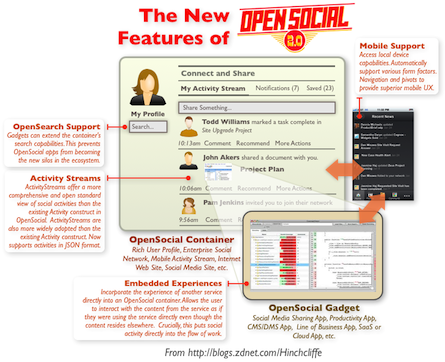OpenSocial 2.0: Will key new additions make it a prime time player in social apps?

The whole premise of efforts like OpenSocial is that social business activities should not be isolated from the work going on in other applications. While everyone is off looking at Google+, the last few weeks have seen a long-maturing social technology reach a significant milestone that has real potential in its own right to fundamentally remake how we use social tools.
A darling of the digerati for a brief time, with some of the more optimistic coverage claiming that it had a reach of over 600 million people back when Facebook was still in its early days, OpenSocial has gone on to have a niche life in delivering social apps to a steadily growing number Web sites and intranets.
To be sure, OpenSocial faced some early challenges -- particularly the fact that Facebook didn't support it -- thus ensuring that the lead developers of the day didn't focus on it, despite a solid vision. This meant that OpenSocial apps, and consequently uptake, never quite reached critical mass -- even though several thousand apps do exist today. While many social networks did (and continue to) support OpenSocial, it languished in the background as both Facebook apps and mobile apps experienced an enormous rise.
Instead, OpenSocial, in particular the standardization effort, increasingly focused on audiences that weren't served well by existing social networking services. These were typically adopters that used multiple social networks or required more control over their apps, as well as those that sought a more modern, simpler, and social approach for intranet portals and applications. These were good niches and kept OpenSocial moving forward. It was a useful focus for enterprise social networks and OpenSocial now has mindshare in this space. OpenSocial currently has support from software vendors as varied as IBM and SAP to SocialText and Jive. In fact, it's fair to say that OpenSocial is one of the very few successful enterprise-friendly social computing standards.
To OpenSocial's credit, as social Web standardization efforts have come and gone over the years, it has had staying power, in part due to its sponsorship by large organizations such as Google and IBM. The standard has expanded steadily and fortunately in my opinion, not too quickly, carefully learning from those that actually try to use it to deliver better and more capable Web portals and intranets. Recently, OpenSocial, facing limited adoption on the Web, has focused on what is likely to be a rich and fertile territory; the emerging social enterprise as organizations seriously consider the benefits of social business models.
As I explored last year, the 1.1 version of OpenSocial released last November focused primarily on integration and tool support improvements for enterprises, making it possible for organizations to use OpenSocial as an intranet technology to create more up-to-date and social media-friendly portals and Web sites. It was an incremental set of improvements, but not one that offered the potential to break out of the mold.
Introducing OpenSocial 2.0
Now in 2011, OpenSocial has the largest revision coming in its history. Version 2.0 brings with it what I think are very significant as well as pretty smart additions that may finally make it compelling for a broad audience as well as the enterprise. While the final list of features is still evolving, the ones that are confirmed will take OpenSocial to a level of maturity, standardization, and sophistication that has made companies like Jive make significant bets on it as their future model for social applications, including their new Jive Apps Market.
As I've discussed previously about the trend towards social operating systems, the whole premise of efforts like OpenSocial is that social business activities should not be isolated from the work going on in other applications. OpenSocial proponents often talk about a 'social context' that business and personal apps can have if they are wrapped in OpenSocial by 1) operating visually and/or physically inside a user's activity stream and 2) making appropriate use of the knowledge that such apps get by residing in OpenSocial containers such as the user's friend list, current activity stream, and other social data.
What OpenSocial 2.0, which should be released this fall, brings to the table makes it much more up-to-date including support for better standardization, embedded 3rd party application experiences, a cross-application federated search model, and much needed mobility features.
Features of OpenSocial 2.0
Here's a breakdown of the new features in OpenSocial 2.0 and why they are significant:
- Embedded User Experiences. This enables the addition of an external user experience from another service directly into an OpenSocial container. This makes it possible for the user to seamlessly interact with the content from the external service as if they were using the service directly even though the content resides elsewhere. Crucially, this puts social activity directly into the flow of work, which enables higher levels of productivity than if users constantly need to switch apps as they do work in their social activity streams. You can see embedded user experiences in action in this recent YouTube video from the Enterprise 2.0 Conference with Andrew Davis of the OpenSocial Foundation and UBM's David Berlind. You can also peruse the OpenSocial Foundation's slides on embedded experiences as well.
- Activity Streams Standardization. The Activity Streams standard offers a more comprehensive and open standard view of social activities than the existing Activity construct in OpenSocial. Activity Streams are also more widely adopted than the existing Activity construct. Now supports activities in JSON format to make it easier to work with and higher performance. The social media industry has widely adopted Activity Streams as a standard on the Web and it's good to see it become an official part of OpenSocial. You can see the details about the standardization effort on the OpenSocial Foundation's activity streams slide presentation.
- Support for Mobile User Experiences. With mobile devices outshipping PCs by a large margin this year, any Web or social technology must be very mobile friendly to succeed as users move en masse to new form factors and touch-based devices. OpenSocial has added a lightweight yet quite feature rich mobile user experience model that includes seamless gadget navigation, orientation support, mobile performance optimizations, access to mobile sensors such as GPS and cameras, and much more. The new mobility support is ambitious, visually sleek, and likely to be popular with users. You can read all the details in the OpenSocial 2.0 mobile overview slides.
- OAuth 2.0. Connecting applications together requires unified identity and safe methods to authorization application usage. OAuth has emerged as the defacto leader in this space and is how social applications delegate usage now on the Web. With the addition of OAuth 2.0, support secure connections between applications is even easier and safer than before.
- OpenSearch support. The addition of OpenSearch can extend an OpenSocial container's search capabilities. This prevents OpenSocial apps from becoming the new silos in the IT ecosystem since user's searches can cross the boundaries of applications that support it. The trick is for OpenSocial apps to support it, which is not required. It will be up to OpenSocial app users to demand support this feature, one that I believe will be key to get the full ROI from the federated social models that powerfully OpenSocial enables.
One of the problems that OpenSocial has had is that there is a pretty low bar for adoption. Just about anyone can wrap their existing application in OpenSocial and ship it as an app to users with very little effort. That's because most of OpenSocial's features are optional to support. Unfortunately, this sort of "paving the cowpath" won't result in nearly as rich and rewarding results if the application developer provided deeper support and made fuller and more meaningful use of the user's social context including friends lists and activity streams. In response to this concern, David Berlind in the video mentioned in the first bullet above asked if OpenSocial was merely a return to the Object Linking and Embedding (OLE) approach Microsoft introduced in the 1990s. The question remains open in my opinion. The gap between making it easy for developers to adopt OpenSocial and meaningfully take advantage of it is pretty large in the end. Yet there is reason to believe that this won't be an real issue.
Fortunately, with the widespread emergence of app stores, much better distribution models for mobile and social apps is arriving. This is going to force more transparency, competition, and feature demand as better conduits are forged between developers and users. OpenSocial is poised to capitalize on this trend in a major way, as long as no better alternative emerges, which is still possible given the state of the market.
Either way, IT departments and end-users have the potential to benefit from the choice, features, standardization, openness, interoperability, and other compelling features that OpenSocial offers and now exists from many major enterprise and online software vendors today. With the new version, OpenSocial has put itself on the path to mainstream adoption, particularly as you can be assured that Google+ will be major supporter, perhaps helping negate the lack of support for OpenSocial in Facebook.
